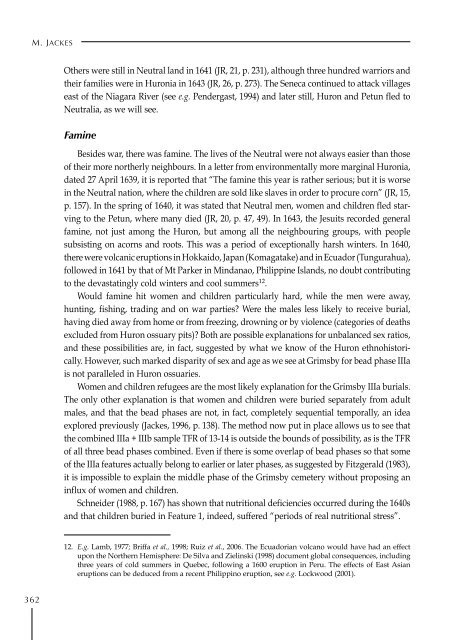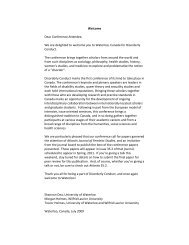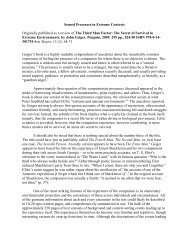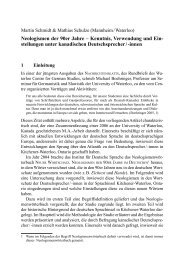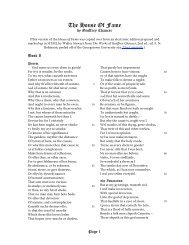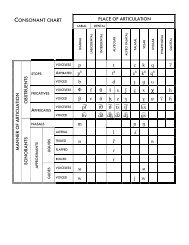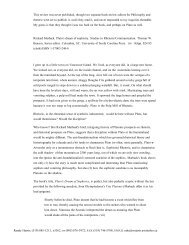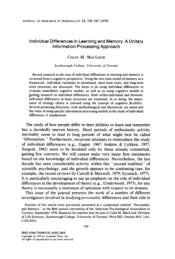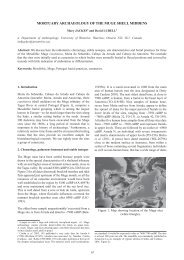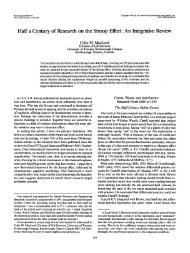The mid seventeenth century collapse of Iroquoian Ontario:
The mid seventeenth century collapse of Iroquoian Ontario:
The mid seventeenth century collapse of Iroquoian Ontario:
You also want an ePaper? Increase the reach of your titles
YUMPU automatically turns print PDFs into web optimized ePapers that Google loves.
M. JackeS<br />
362<br />
Others were still in Neutral land in 1641 (JR, 21, p. 231), although three hundred warriors and<br />
their families were in Huronia in 1643 (JR, 26, p. 273). <strong>The</strong> Seneca continued to attack villages<br />
east <strong>of</strong> the Niagara River (see e.g. Pendergast, 1994) and later still, Huron and Petun fled to<br />
Neutralia, as we will see.<br />
Famine<br />
Besides war, there was famine. <strong>The</strong> lives <strong>of</strong> the Neutral were not always easier than those<br />
<strong>of</strong> their more northerly neighbours. In a letter from environmentally more marginal Huronia,<br />
dated 27 April 1639, it is reported that “<strong>The</strong> famine this year is rather serious; but it is worse<br />
in the Neutral nation, where the children are sold like slaves in order to procure corn” (JR, 15,<br />
p. 157). In the spring <strong>of</strong> 1640, it was stated that Neutral men, women and children fled starving<br />
to the Petun, where many died (JR, 20, p. 47, 49). In 1643, the Jesuits recorded general<br />
famine, not just among the Huron, but among all the neighbouring groups, with people<br />
subsisting on acorns and roots. This was a period <strong>of</strong> exceptionally harsh winters. In 1640,<br />
there were volcanic eruptions in Hokkaido, Japan (Komagatake) and in Ecuador (Tungurahua),<br />
followed in 1641 by that <strong>of</strong> Mt Parker in Mindanao, Philippine Islands, no doubt contributing<br />
to the devastatingly cold winters and cool summers 12 .<br />
Would famine hit women and children particularly hard, while the men were away,<br />
hunting, fishing, trading and on war parties? Were the males less likely to receive burial,<br />
having died away from home or from freezing, drowning or by violence (categories <strong>of</strong> deaths<br />
excluded from Huron ossuary pits)? Both are possible explanations for unbalanced sex ratios,<br />
and these possibilities are, in fact, suggested by what we know <strong>of</strong> the Huron ethnohistorically.<br />
However, such marked disparity <strong>of</strong> sex and age as we see at Grimsby for bead phase IIIa<br />
is not paralleled in Huron ossuaries.<br />
Women and children refugees are the most likely explanation for the Grimsby IIIa burials.<br />
<strong>The</strong> only other explanation is that women and children were buried separately from adult<br />
males, and that the bead phases are not, in fact, completely sequential temporally, an idea<br />
explored previously (Jackes, 1996, p. 138). <strong>The</strong> method now put in place allows us to see that<br />
the combined IIIa + IIIb sample TFR <strong>of</strong> 13-14 is outside the bounds <strong>of</strong> possibility, as is the TFR<br />
<strong>of</strong> all three bead phases combined. Even if there is some overlap <strong>of</strong> bead phases so that some<br />
<strong>of</strong> the IIIa features actually belong to earlier or later phases, as suggested by Fitzgerald (1983),<br />
it is impossible to explain the <strong>mid</strong>dle phase <strong>of</strong> the Grimsby cemetery without proposing an<br />
influx <strong>of</strong> women and children.<br />
Schneider (1988, p. 167) has shown that nutritional deficiencies occurred during the 1640s<br />
and that children buried in Feature 1, indeed, suffered “periods <strong>of</strong> real nutritional stress”.<br />
12. E.g. Lamb, 1977; Briffa et al., 1998; Ruiz et al., 2006. <strong>The</strong> Ecuadorian volcano would have had an effect<br />
upon the Northern Hemisphere: De Silva and Zielinski (1998) document global consequences, including<br />
three years <strong>of</strong> cold summers in Quebec, following a 1600 eruption in Peru. <strong>The</strong> effects <strong>of</strong> East Asian<br />
eruptions can be deduced from a recent Philippino eruption, see e.g. Lockwood (2001).


